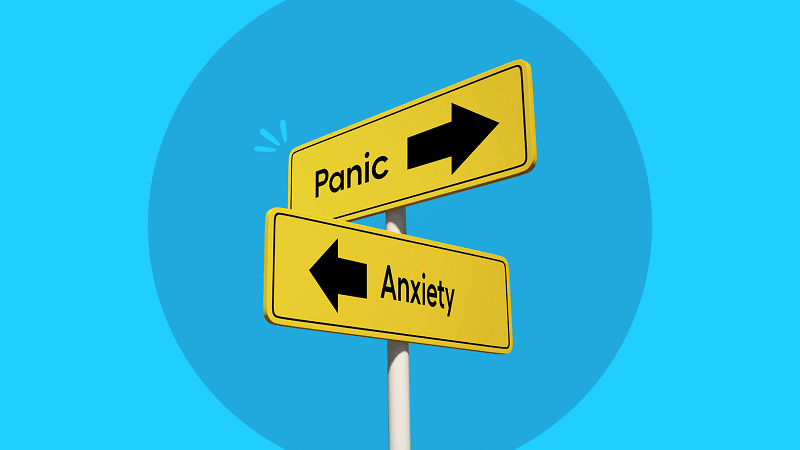There are several similarities between a panic attack and an anxiety attack. But anxiety is often triggered by certain stressors and may build gradually. On the other hand, panic attacks can occur unexpectedly and abruptly.
You might hear people talking about panic attacks and anxiety attacks like they’re the same thing. But they’re different conditions.
What is an anxiety attack
The “Diagnostic and Statistical Manual of Mental Disorders, 5th edition” (DSM-5) does not mention anxiety attacks, but it does define anxiety as a feature of a number of common psychiatric disorders.
This includes the following conditions:
* generalized anxiety disorder
* panic disorder
* separation anxiety disorder
* agoraphobia without history of panic disorder
* post-traumatic stress disorder
* social anxiety disorder
* obsessive-compulsive disorder
* specific phobia
Anxiety is usually related to the anticipation of a stressful situation, experience, or event. It may come on gradually.
Symptoms of anxiety include:
* worry
* distress
* fear
The lack of diagnostic recognition of anxiety attacks means that the signs and symptoms are open to interpretation.
That is, a person may describe having an “anxiety attack” and have symptoms that another person has never experienced despite indicating that they, too, have had an “anxiety attack.”
What is a panic attack
Panic attacks come on suddenly and involve intense and often overwhelming fear. They’re accompanied by very challenging physical symptoms, like a racing heartbeat, shortness of breath, or nausea.
Unexpected panic attacks occur without an obvious cause. Expected panic attacks are cued by external stressors, like phobias.
Panic attacks can happen to anyone, but having more than one may be a sign of panic disorder, a mental health condition characterized by sudden and repeated panic attacks.
Symptoms of panic attack vs. anxiety attack
Panic and anxiety attacks may feel similar, and they share a lot of emotional and physical symptoms.
You can experience both an anxiety and a panic attack at the same time.
For instance, you might experience anxiety while worrying about a potentially stressful situation, like an important presentation at work. When the situation arrives, anxiety may culminate in a panic attack.
It may be difficult to know whether what you’re experiencing is anxiety or a panic attack. Keep in mind the following:
* The cause: Anxiety is typically related to something that’s perceived as stressful or threatening. Panic attacks aren’t always cued by stressors. They most often occur out of the blue.
* The level of distress: Anxiety can be mild, moderate, or severe. For example, anxiety may be happening in the back of your mind as you go about your day-to-day activities. Panic attacks, on the other hand, mostly involve severe, disruptive symptoms.
* Fight-or-flight: During a panic attack, the body’s autonomous fight-or-flight response takes over. Physical symptoms are often more intense than symptoms of anxiety.
* Speed of onset: While anxiety can build gradually, panic attacks usually come on abruptly.
* Effect: Panic attacks typically trigger worries or fears related to having another attack. This may have an effect on your behavior, leading you to avoid places or situations where you think you might be at risk of a panic attack.
Causes of panic attack vs. anxiety attack
Unexpected panic attacks have no clear external triggers. Expected panic attacks and anxiety can be triggered by similar things. Some common triggers include:
* a stressful job
* driving
* social situations
* phobias, like agoraphobia (fear of crowded or open spaces), claustrophobia (fear of small spaces), and acrophobia (fear of heights)
* reminders or memories of traumatic experiences
* chronic illnesses, like heart disease, diabetes, irritable bowel syndrome, or asthma
* chronic pain
* withdrawal from drugs or alcohol
* caffeine
* medication and supplements
* thyroid problems
Risk factors for panic attack vs. anxiety attack
Anxiety and panic attacks have similar risk factors. These include:
* experiencing trauma or witnessing traumatic events, either as a child or as an adult
* experiencing a stressful life event, like the death of a loved one or a divorce
* experiencing ongoing stress and worries, like work responsibilities, conflict in your family, or financial woes
* living with a chronic health condition or life threatening illness
* having an anxious personality
* having another mental health condition like depression
* having close family members who also have anxiety or panic disorders
* using drugs or consuming alcohol
People who experience anxiety are at an increased risk of experiencing panic attacks. But having anxiety does not mean you will experience a panic attack.
Lifestyle changes
The following lifestyle changes can help you prevent anxiety and panic attacks, as well as reduce the severity of symptoms when an attack occurs:
* Reduce and manage sources of stress in your life.
* Learn how to identify and stop negative thoughts.
* Get regular, moderate exercise.
* Practice meditation or yoga.
* Eat a balanced diet.
* Join a support group for people with anxiety or panic attacks.
* Limit your consumption of alcohol and caffeine as well as the use of drugs.


